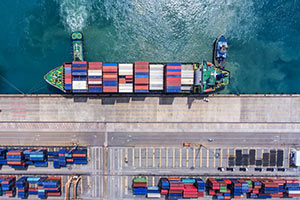When Does Trade Adjust after Being Liberalized?

When a country liberalizes trade, trade tends to increase substantially. However, the full effects take many years, and imports tend to dominate exports in the short run, according to a recent Economic Synopses essay.
Economist Fernando Leibovici and Senior Research Associate Jonas Crews considered a country open to trade if five conditions were met:
- Average tariff rates were below 40 percent.
- Nontariff barriers covered less than 40 percent of trade.
- The black-market exchange-rate premium was less than 20 percent, if such a market existed.
- The government did not monopolize major exports.
- The country was not socialist.
For 88 countries, the authors examined the 20 years both before and after each country first met all five criteria.It should be noted that very few of the 88 countries had data available for the full 40-year period. For each year, the authors computed the average exports-to-GDP ratio for the countries for which data are available. They found that the average exports-to-GDP ratio rose more than 8 percentage points over the 20 years following trade liberalization.
However, the impact wasn’t immediate. Leibovici and Crews noted that the ratio increased only 4.3 percentage points in the first decade after trade liberalization. “These dynamics may reflect the time it takes new exporters to adapt their production decisions to the lower trade barriers,” they wrote.
Imports vs. Exports
The authors also contrasted how trade liberalization affects exports and imports. They found that imports increased more rapidly in the short run. “Imports might grow immediately because they come from large international markets, which do not necessarily require an increase in production capacity,” they noted.
They added that in the long run, however, exports and imports increased by a similar amount, with trade imbalances returning to pre-liberalization levels.
Leibovici and Crews noted that these short-run imbalances might help explain some of the resistance to trade liberalization. “To the extent that imports adjust faster than exports after trade liberalization, policymakers may face relatively stronger resistance when advocating for subsequent rounds of trade liberalization,” they wrote.
Notes and References
1 It should be noted that very few of the 88 countries had data available for the full 40-year period. For each year, the authors computed the average exports-to-GDP ratio for the countries for which data are available.
Additional Resources
- Economic Synopses: Trade Adjusts Gradually After Trade Liberalization
- On the Economy: Would Economic Nationalism Benefit the U.S.?
- On the Economy: U.S. Trade Deficit Driven by Goods, Not Services
This blog offers commentary, analysis and data from our economists and experts. Views expressed are not necessarily those of the St. Louis Fed or Federal Reserve System.
Email Us
All other blog-related questions


